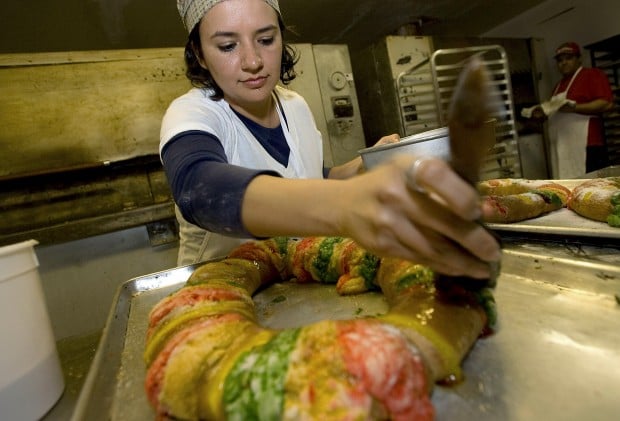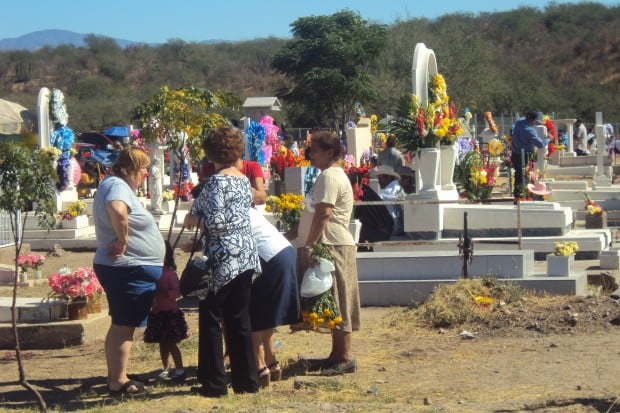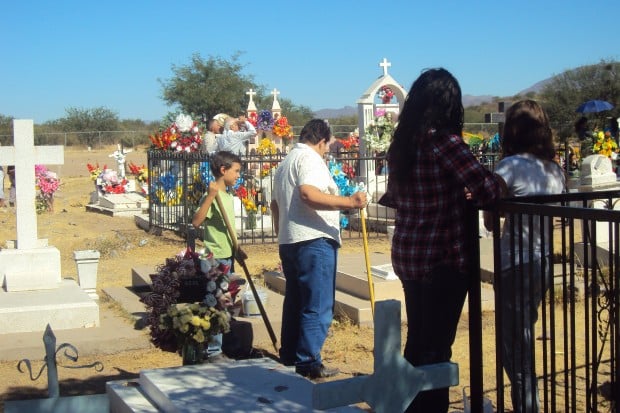Flores vívidas cubrían las lápidas. Los colores contrastaban fuertemente con la tierra del desierto que cubría cientos de tumbas.
Me encontraba en Cumpas, Sonora, el Día de los Muertos, lejos de Tucsón, donde mis abuelos y antepasados están sepultados. Pero en este viejo pueblo, al pie de la Sierra Madre, me sentí en casa -entre los vivos y los muertos.
Cumpas es el pueblo de la familia de Ernesto Grijalva Acuña, quien radica en Puerto Peñasco. Él y su esposa Elsa Ibarra Murrieta de Grijalva y su hermano Luis Grijalva Acuña repartieron docenas de gladiolas sobre las tumbas de sus familiares.
Ellos me invitaron al camposanto en Cumpas, para honrar la memoria de los muertos.
Ahí en Cumpas, más o menos unas dos horas al Sur de Agua Prieta, generaciones de familias están enterradas y continúan viviendo, trabajando, celebrando el pasado y dándole la bienvenida al futuro.
Cuatro generaciones de la familia Grijalva están enterradas en Cumpas y en la colonia cercana de Teonadepa -una hermana, sus padres, abuelos, bisabuelos. También sus tíos y tíos abuelos están sepultados en esta tierra antigua.
Cumpas es principalmente conocido por su caballo tenaz, El Moro, que perdió una aguerrida carrera contra El Zaino de Agua Prieta en 1957. Una gran estatua blanca de El Moro se encuentra en la entrada del pueblo, dándole la bienvenida a los visitantes y residentes.
Pero la esencia de Cumpas continúa siendo su gente, sonorenses trabajadores que están conectados al cercano Río Moctezuma, como a la tierra donde pastan los animales y siembran los cultivos. No muy lejos de Cumpas se encuentra los valles del chiltepín. La caña de azúcar se cultiva en la sierra y el maíz y el trigo se cultivan en el valle.
Mientras generaciones de familias han nacido y muerto en Cumpas, otras generaciones se han aventurado al Norte a vivir y trabajar en Estados Unidos. Cumpas ha extendido sus lazos familiares a través del desierto hasta Tucsón y el Sur de Arizona. Incluso, las familias que se reunieron en el cementerio de Cumpas, el cual continúa creciendo, fueron desde Tucsón, Douglas, Hermosillo, entre otros sitios.
Las tumbas eran tan variadas como las flores que las cubrían.
Algunas eran elegantes, rodeadas por rejas de hierro forjado y protegidas del sol por pequeñas ramadas de acero laminado. Unas cuantas no tenían adornos con la excepción de una cruz de madera desgastada y piedras o ladrillos que marcaban el lugar de sepultura.
Pero la mayoría de las lápidas eran modestas, hechas de granito o cemento y con una figura o imagen religiosa labrada en la piedra. Familiares barrían el suelo alrededor de las tumbas y regaban la tierra. Otros lavaban las lápidas.
Los cementerios contienen a los muertos, pero en algunos casos los muertos continúan viviendo. Allí, entre los sepultados, hay una mujer que se dice que era de mala fama. Los hombres disfrutaban de su compañía.
Cuando murió, fue enterrada en las afueras del cementerio. Como éste se expandió, la tumba de la mujer resultó incorporada adentro del cementerio junto con todos los demás.
Pero, como dice la historia, un narco visitó la tumba de la mujer. Puede que la conociera, puede que no. Sin embargo, fue a la tumba de la mujer y le pidió un favor. Se le cumplió.
Creyendo que la mujer se lo había concedido, el hombre le construyó una nueva sepultura decorada con azulejos y rodeada por una reja de hierro forjado.
Actualmente, desconocidos visitan la tumba, prenden velas y susurran sus peticiones.
Pero en el lugar donde se sepultan los Grijalva no se estaba susurrando. Había conversaciones en voz baja y un poco de risa y alegría por los antepasados que continúan viviendo en los recuerdos.
Fue un gran día para estar en Cumpas, compartiendo la felicidad de otros y sus historias.
Contacta a Ernesto Portillo Jr. al netopjr@azstarnet.com o al 520-573-4187.
Blankets of brightly colored flowers covered the tombstones. The burst of colors contrasted sharply with the brownish shades of high desert dirt which held several hundred grave sites.
I was in Cumpas, Sonora, for the Day of the Dead, far away from Tucson, where my abuelos and antepasados are buried. But in this small, old town, in the shadow of the Sierra Madre, I felt at home - among the living and the dead.
Cumpas is the family home of Ernesto Grijalva Acuña of Rocky Point, who along with his wife Elsa Ibarra Murrieta de Grijalva and his brother Luis Grijalva Acuña delivered dozens of gladiolas to the family's grave sites. I was there in Cumpas and the cemetery at their invitation to celebrate the memories of the dead.
There in Cumpas, about two hours south of Agua Prieta, generations of families are buried and continue to live, work and celebrate the past and welcome the future.
There are four generations of Grijalva's family buried in Cumpas and in the nearby colonia of Teonadepa - a sister, parents, grandparents and great-grandparents. There are also uncles and great uncles interred in the ancient land.
Cumpas is mainly known for its tough hometown horse, El Moro, which lost a close race to El Relámpago of Agua Prieta in 1957. A large white statue of El Moro stands at the main entrance of the town, welcoming visitors and residents.
But the essence of Cumpas remains its people, hardworking Sonorenses who are as connected to the nearby flowing Río Moctezuma as they are to their land on which they graze their animals and grow their food.
Not far from Cumpas is the valley of the chiltipín. Sugarcane is grown in the sierra, and corn and wheat are grown in the valleys.
While generations of families of Cumpas have grown up and died there, generations of families have also ventured north to live and work in the United States. In Tucson and Southern Arizona alone, Cumpas has extended its family ties to our desert.
And from Tucson, Douglas, Hermosillo and other points, the families of Cumpas were reunited in the expanding cemetery.
The grave sites were as varied as the flowers that covered them.
There were elegant ones, enclosed by wrought iron grills and protected from the sun by small ramadas of laminated steel. There were a few, unadorned with the exception of a weathered wooden cross and pile of rocks or bricks marking the final resting place.
But most of the headstones were modest, made of granite or cement with a religious figure or image implanted on the stone. Family members swept the hard earth around the grave sites and watered the loose dirt. Others washed the grave sites.
Burial grounds contain the dead but in some cases the dead continue to live.
In the Cumpas cemetery a woman is buried. Story says that she was a woman of ill-repute. Men enjoyed her company.
When she died, she was buried outside the cemetery. As the cemetery's size grew the woman's burial site was incorporated into the cemetery where she joined the other dead.
But, as the story goes, a narco visited the woman's grave. He may have known her or he may have not. Still he went to the woman's grave, asked for a special favor. It was granted.
Believing the dead, unwanted woman was responsible, the man built a new grave site, lavishing it with tile and enclosing it with wrought iron.
Today strangers visit the grave site, lighting candles, whispering their requests.
But at the Grijalva grave site there was no whispering. There was quiet talk and some laughter of joy about the families who came before and who continue to live in memories.
It was a great day to be in Cumpas, sharing in the happiness of others and in their stories.






